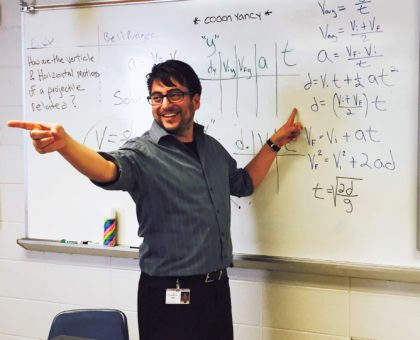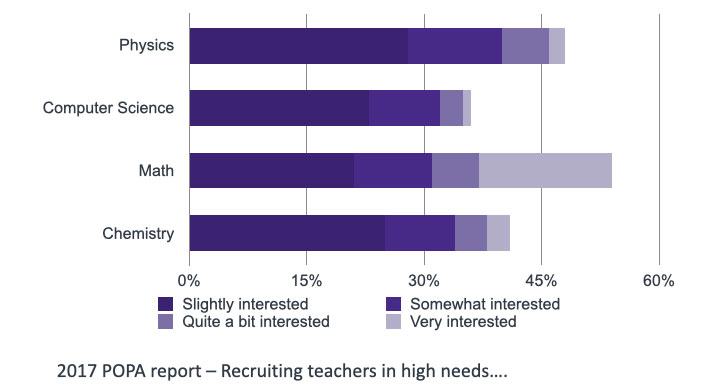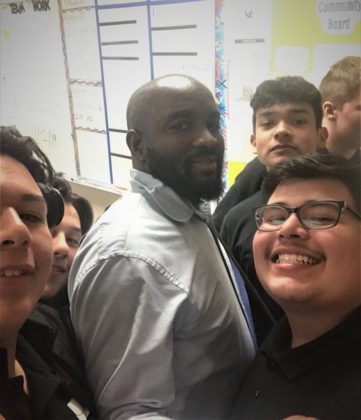Facts about the teaching profession
How does a teaching career stack up to other careers you can get with the same degree? Explore job satisfaction, work-life balance, salary, benefits, retention, creative freedom, respect, and impact.
Did you know…
✔ At year 15, the middle 50% of teacher salaries ranges between $68,000 and $114,000, nationally.
✔ Teacher salaries are competitive with other jobs you can get with the same degree.
✔ Grade 7-12 science and math teachers get paid more than most college teaching faculty.
✔ You can get a job almost anywhere in the U.S. or abroad as a science or math teacher.
✔ There are student loan forgiveness programs and scholarships for math and science teachers.
✔ Most teaching jobs have better retirement benefits than other jobs you can get with the same degree.
✔ Nearly all teachers report having creative freedom in their classrooms.
✔ 87% of teachers report that they are treated with respect by students and their parents.
✔ About half of all science and math majors report an interest in becoming a teacher.
✔ Behind every advance in medicine or technology is a teacher who left a lasting impression.
Percentage shown is the % of people ranking their lives at the top of the ladder* minus the % of people ranking their lives at the bottom of the ladder.*
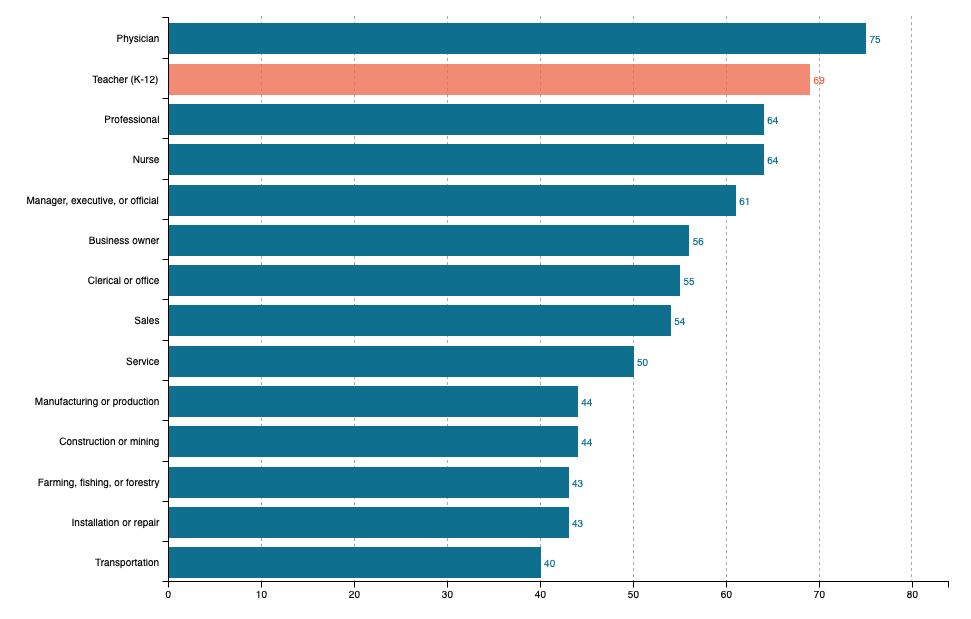
*The Cantril Self-Anchoring Scale
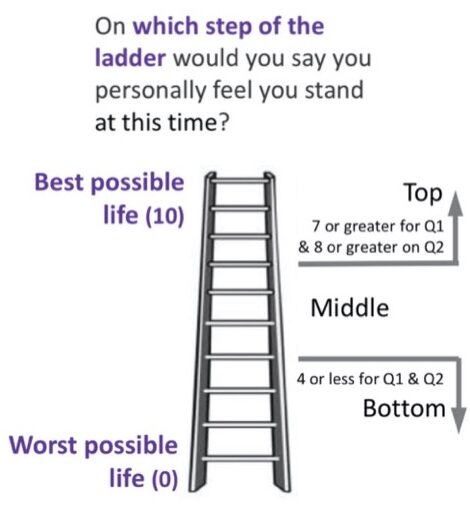
Results are based on telephone interviews conducted as part of the Gallup-Healthways Well-Being Index survey with a random sample of 172,286 workers, aged 18 or over, from Jan. 2-Dec. 30, 2012. For results based on the total sample of national adults, one can say with 95% confidence that the maximum margin of sampling error is ±3.5 percentage points for the smallest group (physicians) but less than ±1 for larger groups such as professionals, service workers, or managers/executives.
From Cantril, H. The pattern of human concerns. New Brunswick, NJ: Rutgers University Press, 1965.
 Why do teachers rate their lives so highly compared to other professionals?
Why do teachers rate their lives so highly compared to other professionals?
For the past five years Get the Facts Out has been working to understand why teachers rate their lives so highly. We’ve mined data from lots of different sources and collected some of our own. What we have found falls into three main categories:
- Work-Life Balance
- Student and Colleague Relationships
- Financial Stability
The sections below provide facts and data to support these three advantages to the teaching profession.
Typical teacher salary facts:
- Teacher’s receive yearly raises for years of experience, cost of living, and continued education in the teacher’s subject area. Salary tables for most districts are publicly availably online.
- About half of science and math teachers earn a Masters degree by age 30. There are degree programs across the U.S. designed for practicing teachers to earn their degree while teaching full time.
- Teacher’s receive additional pay for any work outside of the classroom including coaching, student clubs, or subbing for a fellow teacher. See below for more info.
Example Base Teacher Salaries
| District | Bachelor's degree Year 1 | Bachelor's degree Year 5 | Master's degree Year 5 | Master's degree Year 15 | Doctoral degree Year 1 |
|---|---|---|---|---|---|
| Jackson Public Schools (Jackson, MS) [1] | $43,721 - $44,218 | $46,746 - $47,156 | $48,971 - $49,506 | $56,122 - $56,742 | $48,603 - $49,297 |
| Billings Public Schools (Billings, MT) [2] | $41,803 - $54,723 | $47,769 - $63,411 | $56,783 - $64,911 | $72,283 - $82,789 | $56,480 - $58,223 |
| Boulder Valley School District (Boulder, CO) [3] | $54,789 - $64,535 | $58,275 - $70,833 | $77,202 - $101,992 | $83,565 - $124,605 | $93,708 - $95,817 |
| Half Hollow Hills Central School District (Dix Hills, NY) [4] | $59,364 - $70,016 | $72,307 - $83,997 | $83,177 - $101,299 | $113,206 - $130,291 | $83,662 - $87,251 |
| Long Beach Unified School District (CA) [5] | $69,749 - $69,754 | $72,944 - $83,492 | $80,354 - $93,725 | $106,266 - $121,569 | $72,470 - $80,973 |
- Jackson Public Schools – 2022-2023 Teacher Salary Scale
- Billings Public Schools – 2021-2022 Salary Schedule
- Boulder Valley Schools – 2022-2023 Pay Schedule
- Half Hollow Hills Central District- 2023-2024 Pay Schedule
- Long Beach Unified Schools – Certified non-management 2022-2023 salary schedule
The above table contains a sampling of salaries from across the nation.
- Jackson Public Schools in Mississippi are located in the South where the median household income is $46,300.
- Billings, MT median household income is $57,403.
- Boulder Public Schools in Colorado, represents a large urban district where the median household income is $74,256.
- Long Beach Public Schools in California represent a West coast large urban district where the median household income is $69,316.
Example Administrator Salaries
| St. Vrain Valley Schools Administrator Salaries | |||
|---|---|---|---|
| Calendar | Minimum | Maximum | |
| Asst. Principal- High School | 215 Days | $106,596 | $147,205 |
| Director – Innovation Programs | 248 Days | $118,819 | $164,083 |
| Principal - High School | 225 Days | $131,042 | $180,963 |
| Asst Superintendent – Innovation Center | 248 Days | $173,327 | $239,356 |
| Deputy Superintendent | 248 Days | $208,955 | $288,557 |
Data to Back Up the Facts
To learn more and dive deeper into the facts about the profession and the data to back up the facts, check out the following page: Our Research and Publications




 On several occasions we have had a group of teachers and other professionals sit down and review data about their respective professions, reflect on their own experiences, and talk about the benefits of each other’s careers.
On several occasions we have had a group of teachers and other professionals sit down and review data about their respective professions, reflect on their own experiences, and talk about the benefits of each other’s careers.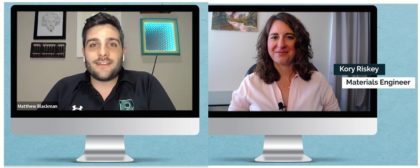
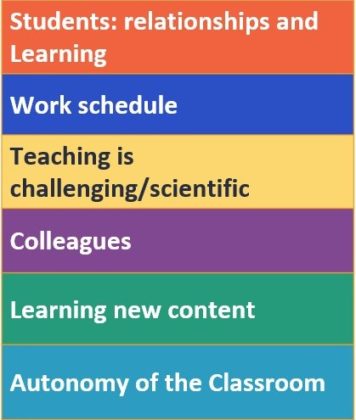




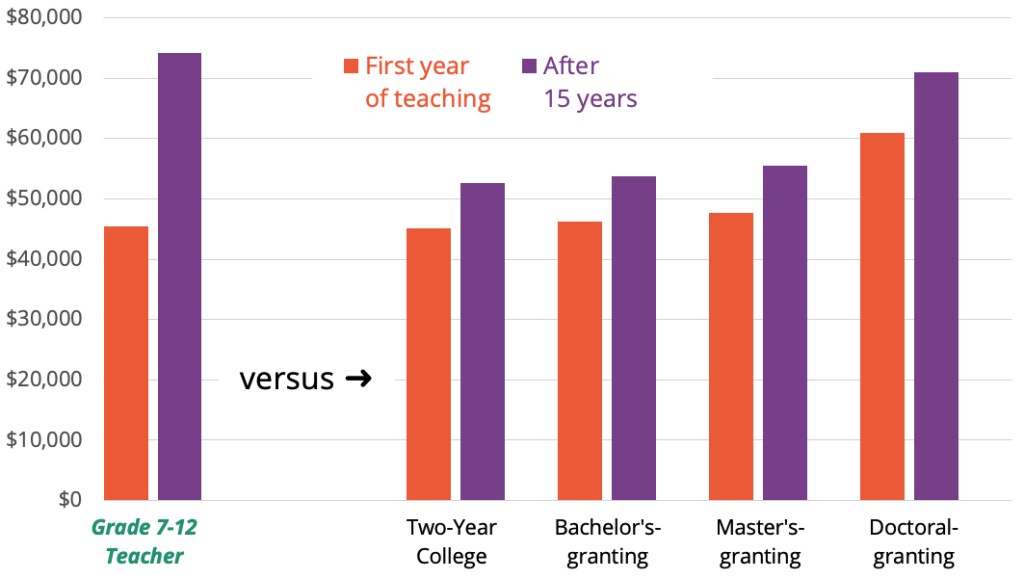
 Math and science teachers are in high demand and there are open positions in every area of our nation.
Math and science teachers are in high demand and there are open positions in every area of our nation.